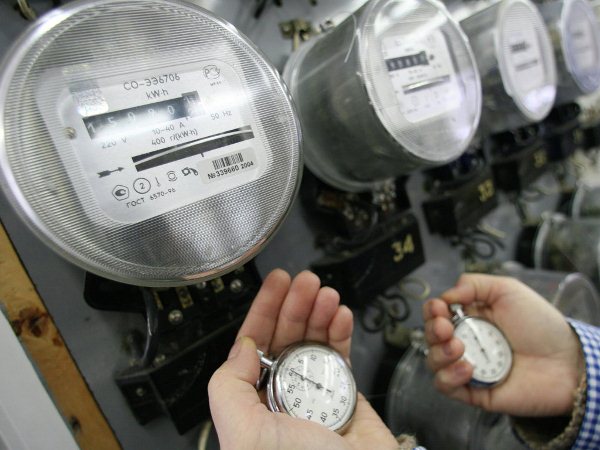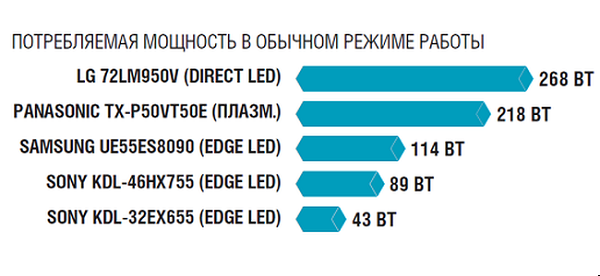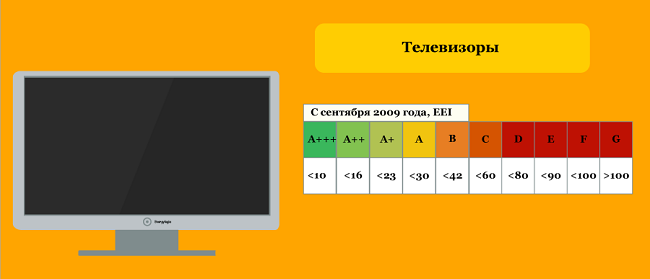How to find out the power consumption of your TV
Today, life without a “blue screen” is practically not thought of by anyone: such a technique shares the events taking place in the world, teaches, relaxes, and can even help surf the web pages. However, not every one of us thinks about how much electricity a television consumes. But this is a significant item of expenditure.
Content
General information
Information on the power consumption of the TV model can be found, of course, in the document accompanying it - technical passport. The compilers usually provide information on how much the device consumes in the mode of its maximum power, and during the wait. If suddenly the technical manual is lost, then the necessary information can be found on the Internet, you only need know exactly the model of your television.
You can make independent measurements, but for this you need special tools on hand. The power of the TV will show the power meter, which will determine this figure almost instantly.
Calculations different types of televisions may show that completely different numbers will be consumed. Knowledge of this may well affect the decision to purchase a particular device model.

Calculations for different types of TVs
The data in the bill for the consumption of electricity of a particular TV depends not only on the type of the device itself, but also his time. The consumer, on average, spends about 5 hours a day on it, which “attacks” for 150 hours in a month. And then it remains to figure out which of the devices is the most "voracious."
Cathode ray tube
Practically all of us have grown up with such TV sets - these are bulky models that have a kinescope. They are unpretentious in operation, have a long service life, but can not boast of energy savings, because their consumption is 60-100 watts per hour. During the day, the amount of not less than 0.5 kW comes out, and in a month the figure will rise to 15.In standby mode (that is, around the clock), the indicator in watts will be equal to 2-3 units. The result for the month - from 16 to 18 kW.

Plasma
Such panels will be interested in superpicture in terms of color and saturation, but in terms of energy efficiency, they are far from ideal. If we take different modes of operation, we get 150–190 W / h in operation and 0.5 watts on standby. For the month goes 24.36–28.86 kilowatts.
Liquid crystal
LCD TVs compared to plasma much more economical. But they have great importance for the power of the TV has diagonal size, what you should not forget when choosing device size.
- With rates of up to 32 inches, there will be about 40 to 55 watts per hour and only 1 watt on hold.
- A screen of about 49 inches will take 100–150 W / h and up to 22.72 kW per month.
- LED-type will take another 40% less due to the use of diodes in the backlight.
Thus, the LCD version of TVs is the most profitable for power consumption.. But you can save by knowing other criteria.

Actual characteristics of the model
In addition to its type, any TV has other important factors, given that, you can choose for yourself the best technique.
- Consumption class. The highest is A (there are markings that increase the savings - A +, A ++, A +++).

- Presence of eco-modes. They are needed in order to reduce the brightness of the picture, thereby reducing the power of the TV. This can be done manually or in auto mode (special sensors are needed for the latter).
- Presence sensors they evaluate the situation in front of the screen: if the movements of people or faces are not recognized, the device will simply turn off.
How to save when using the TV
To further optimize your television receiver, you can follow these recommendations.
- The equipment must be installed in a room that has uniform lighting. In this case, the brightness and contrast settings will be minimized.
- Brightness is best tuned for different types of lighting: in the dark it can be less without loss of comfort when viewing.
- It is better to turn off the device from the outlet - it will save performance in standby mode.

- Actually use all available eco-functions.
The constant rise in prices for utilities has made it imperative to save resources, including electricity. For many of us, televisions work around the clock, and in some families there are several such devices.Knowledge of the consumption of its model of the teledevice will not be puzzled by the number of digits in the final bill of the receipt.

/rating_on.png)












